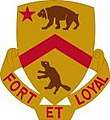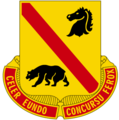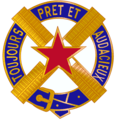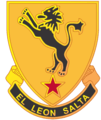61st Cavalry Division (United States)
The 61st Cavalry Division was an Organized Reserve cavalry unit of the United States Army.
| 61st Cavalry Division | |
|---|---|
 Shoulder Sleeve Insignia of the 61st Cavalry Division | |
| Active | 1921–1942 |
| Country | United States |
| Branch | United States Army |
| Type | Cavalry |
| Garrison/HQ | New York City (1922–1941) |
| Nickname(s) | "The Foragers" |
| Commanders | |
| Notable commanders | George B. Duncan |
U.S. Cavalry Divisions | |
|---|---|
| Previous | Next |
| 24th Cavalry Division | 62nd Cavalry Division |
It was created in 1921 from the perceived need for additional cavalry units after World War I, and was numbered in succession of the Regular Army Divisions, which were not all active at its creation. The 61st was officially disbanded on 30 January 1942, although most of its personnel had been reassigned in 1941. The unit was nicknamed "The Foragers".
The Division was composed of personnel from New York and New Jersey. The Division Headquarters was initially located in Rochester, New York, but moved to New York City in 1922.
Organization
In early 1940, the division included the following units:[1]
- Headquarters (Manhattan)
- Headquarters, Special Troops (Rochester)
- Headquarters Troop (Manhattan)
- 61st Signal Troop (Buffalo)
- 581st Ordnance Company (Medium) (Buffalo)
- 461st Tank Company (Light) (Manhattan)
- 151st Cavalry Brigade (Rochester)


- 152nd Cavalry Brigade (Manhattan)


- 861st Field Artillery Regiment (New York City)
- 461st Reconnaissance Squadron (reorganized from the 151st Machine Gun Squadron in 1929) (Albany)
- 401st Engineer Squadron (New York City)
- 361st Medical Squadron (Albany)
- 461st Quartermaster Squadron (Rochester)

Standard organization chart for a Cavalry Division in November 1940
Notable Personnel
- William J. Donovan was the first commanding officer of the 301st Cavalry Regiment.
- Terry de la Mesa Allen served as the executive officer of the 303rd Cavalry Regiment.
- Brice Pursell Disque commanded the 151st Cavalry Brigade from June 6, 1922, to April 14, 1937. From April 15, 1937, to June 1939, he commanded the 152nd Cavalry Brigade.
gollark: As you can see, I know all.
gollark: Is this from mikipedia?
gollark: We do a medium-scale project for 20% of the final grade. Mine is to be osmarkscalculator™. I haven't actually started on it yet.
gollark: * is, I should say
gollark: Anyway, the school's CS education was not great and/or some people in the class were quite bad at it.
See also
References
Citations
- Clay 2010a, p. 581.
Bibliography
- Clay, Steven E. (2010a). US Army Order of Battle 1919–1941 (PDF). 2. Fort Leavenworth, Kansas: Combat Studies Institute Press. ISBN 9781780399171.
- Clay, Steven E. (2010b). US Army Order of Battle 1919–1941 (PDF). 4. Fort Leavenworth, Kansas: Combat Studies Institute Press. ISBN 9780984190140.CS1 maint: ref=harv (link)
- Wilson, John B. (1998). Maneuver and Firepower: The Evolution of Divisions and Separate Brigades (PDF). CMH Pub 60–14–1. Washington, D.C.: Center of Military History.CS1 maint: ref=harv (link)
- Sawicki, James A. (1985). Cavalry regiments of the US Army. Dumfries, Virginia: Wyvern Publications. ISBN 9780960240463.CS1 maint: ref=harv (link)
- ”, The Trading Post, Journal of the American Society of Military Insignia Collectors, April- June 2009, page 21
External links
- Formations of the United States Army
This article is issued from Wikipedia. The text is licensed under Creative Commons - Attribution - Sharealike. Additional terms may apply for the media files.